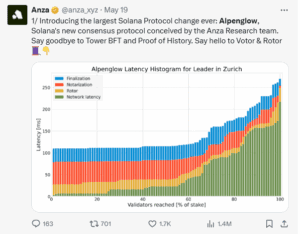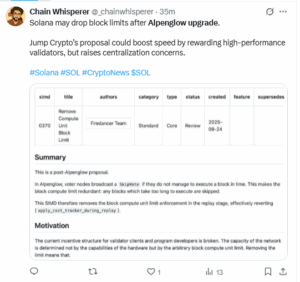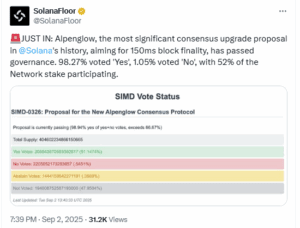Solana transactions still take over 12 seconds to reach finality — far too slow for real-time trading and gaming. The upcoming Solana Alpenglow upgrade promises to cut that to just 150 milliseconds. Can it really deliver, and what does it change under the hood? Let’s see.
Why Solana Needs an Upgrade
Solana (SOL) has long been seen as a fast blockchain. Its design, built around Proof of History (PoH) and Tower BFT, allows it to process thousands of transactions per second. PoH acts as a cryptographic clock that orders events, while Tower BFT coordinates validator votes to reach agreement on blocks.

This model gave Solana its reputation for speed, but it has a hidden problem: true finality. While transactions appear confirmed quickly, they only become irreversible after 12–13 seconds. For DeFi trading, gaming, and enterprise use cases, this lag is significant.
Alpenglow upgrade is Solana’s attempt to fix this bottleneck. By replacing key parts of consensus and restructuring validator economics, it aims to deliver deterministic finality in just 100–150 milliseconds — essentially instant by human perception.
How Alpenglow Rewrites Consensus
The most important change comes from Votor, a new consensus protocol.
Today, validators vote by sending transactions to the chain, which are then confirmed along with other data. This creates both cost and delay. Votor removes this overhead by moving votes off chain. Validators exchange signatures directly and then generate compact certificates that prove a block’s finality. Only these certificates are recorded on chain.
This design has several advantages:
- Finality can be achieved in a single round of voting under normal conditions.
- A second round serves as a fallback if the network is unstable.
- The result is deterministic finality — once certified, a block cannot be reversed.
In essence, Votor replaces the heavy, on-chain voting of Tower BFT with a faster, leaner model.
Rotor: Speeding Up Data Propagation
Consensus speed alone is not enough. Data also needs to reach validators quickly. Solana’s current system, Turbine, relies on multi-hop gossip, where blocks travel across several validators before reaching the whole network. While resilient, it adds delay.
Alpenglow introduces Rotor, a new protocol designed for faster, more uniform data propagation. By reducing the number of hops, Rotor ensures validators see blocks almost instantly, keeping pace with Votor’s faster voting.
Another major change is how Alpenglow handles failures. The upgrade adopts a 20 + 20 resilience model:
- Up to 20% of validators can act maliciously.
- Another 20% can go offline.
- Even in this worst-case scenario, the network continues to operate safely and without forks.
This approach provides stronger guarantees than earlier designs, though it requires validators to maintain higher levels of reliability and redundancy.
Validator Admission Tickets Replace Expensive Vote Transactions
For validators, Alpenglow introduces a fundamental change in economics. At present, validators spend heavily on vote transactions each epoch, resulting in unpredictable costs and wasted block space. Alpenglow replaces this with Validator Admission Tickets. Each validator will pay a fixed fee, currently set around 1.6 SOL per epoch, in order to participate. The fee is burned rather than redistributed, which has the added effect of slightly reducing token inflation.
This new model makes validator costs more predictable and removes the bloat caused by vote transactions. Supporters argue that it levels the playing field, but critics warn it could disadvantage smaller validators. A fixed admission fee may discourage participation by operators with limited resources, raising concerns about the long-term effects on decentralization.

Alpenglow Secures 99% Approval with Rollout Set for 2026
Because Alpenglow changes the core rules of Solana, it had to be approved by the community. The proposal, called SIMD-0326, went to vote in August 2025. About 52% of all staked SOL took part in the vote. Almost 99% supported the upgrade. The strong result gave developers the green light to move ahead.

The plan is to first launch Alpenglow on a testnet in December 2025. If testing goes well, the mainnet upgrade will happen in early 2026. The rollout will be phased. Votor will come first, while Rotor will be added later.
At the same time, Solana is preparing another important development: Firedancer. This is a new validator client built by Jump Crypto. Right now, most of the network relies on a single client called Agave. If it fails, the whole network is at risk. Firedancer will reduce that risk by giving Solana a second client option.
Another proposal, SIMD-0370, is also being discussed. It would remove fixed limits on compute and allow block sizes to adjust as needed. Together with Alpenglow, it could improve both speed and scalability.
Alpenglow also connects with SIMD-0370, a proposal to remove fixed compute limits and allow dynamic block sizing. This would let Solana scale block resources as needed, complementing Alpenglow’s speed improvements. Together, these upgrades target both latency and scalability.
What Alpenglow Could Unlock
If Solana Alpenglow upgrade works as planned, Solana will behave much more like Web2 services. Transactions will settle instantly, building trust for traders, gamers, and institutions. Real-time trading will become smoother. In-game purchases and NFT transfers will feel instant. Enterprises will see a blockchain that can handle real-time settlement for tokenized assets.
Validators will have lower overhead. Developers will be able to design applications that feel as responsive as websites or mobile apps.
Such a large upgrade also carries risks. Rewriting consensus is complex, and even small bugs could cause problems. The fixed admission fee might discourage smaller validators, leading to centralization. Until Firedancer is fully launched, Solana will still depend heavily on Agave.
Another challenge is whether the network can consistently achieve 150-millisecond finality across the globe. It is possible in theory, but real-world conditions are harder. Wallets, block explorers, and RPC providers will also need to update their systems. If they fall behind, users could face disruptions.

